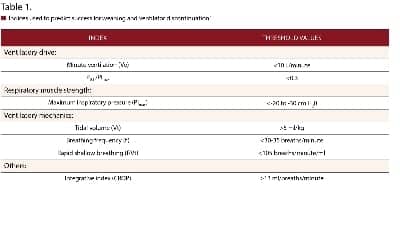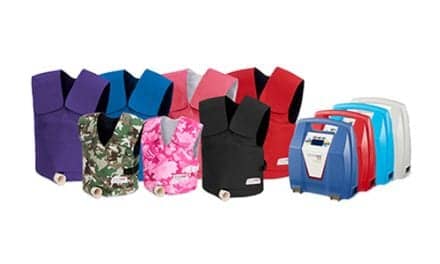Intubating certain patient populations offers RTs huge challenges and requires skill and cool-headedness.
By Rich Smith
Not much can go wrong when establishing or maintaining an airway for a normal-sized adult patient comfortably tucked into bed within the four walls of a quiet hospital.
However, all bets are off when the patient is a severely obese adult, or a newborn baby, or anybody on a stretcher aboard an air ambulance. In those instances, intubation and assisted breathing form a huge challenge, with risk of serious injury to the patient—even death—always present.
“Intubation is best done in a controlled environment where we can position our patients optimally and have all of our assessment tools available to safely establish a secure airway, but there are situations in which this is just not possible,” says Wade Scoles, RRT, NREMT, staff education coordinator for Northwest MedStar, an air-and-ground transport service in Spokane, Wash. “In a helicopter, for instance, it’s incredibly noisy, which makes it impossible to use your ears to assess the patient’s response to bronchodilator therapy, verify endotracheal tube placement, and determine adequacy of ventilation.”
As if the deafening engine roar were not bad enough, a chopper ride is frequently bumpy and offers only cramped seating. Thus, having to intubate the patient during an in-flight emergency is something Scoles and his airborne colleagues hope to avoid. “Fortunately, in 14 years of critical care transport, I’ve only had to intubate two patients while aloft,” he says. “You do it by sitting on the floor with the patient’s head between your legs. It’s not the most optimal situation to be in.”
A Weight-and-See Position
A respiratory therapist need not look to the skies to find daunting intubation challenges. On the ground, inside every hospital, are severely obese patients—individuals whose submandibular areas are covered with thick, heavy folds of flesh. In order to intubate these patients, it is necessary to push mounds of flesh away from the glottic opening. That requires strength and stamina.
Patience, too.
Mark Grzeskowiak, RCP, RRT, supervisor of adult critical care at Long Beach Memorial Medical Center in Long Beach, Calif, recently spent 3 hours alongside an otolaryngologist and an intensivist attempting to correctly intubate one moderately overweight adult male. “We used a laryngoscope to hold the airway open, and a fiber-optic endoscope to try to find the vocal chords,” he recounts. “The endoscope had an endotracheal tube loaded on, so the scope acted as a very long stylet.” None of this worked, so they ended up performing a cricothyrotomy on him.
At Long Beach Memorial, the respiratory team defines an obese patient as someone with a body mass index greater than 35 and/or a neck circumference of more than 18 inches. Taken together, those criteria translate into problems for therapists trying to extend the patient’s head back far enough to be able to visualize the anatomy when an airway emergency arises.
“Not only that, but anatomic landmarks inside the pharynx can be hidden by folds of redundant tissue,” says Grzeskowiak. “It’s hard to know behind which door the airway is located, so to speak.
“After a trach tube has been placed in an obese patient, it would be prudent to use a bronchoscope to verify that the tube has been properly placed,” he says. “The scope would first be inserted through the trach tube to see that it is in proximity to the carina. Next, the scope should be inserted through the patient’s mouth to make sure that the distal aspect of the tube is comfortably in the trachea. If the tube is too short, only the tip of the tube will be in the trachea, increasing the chance for dislodgement.”
Once a tube is successfully placed, inflating the lungs can prove tricky owing to the extraordinary tissue mass above the chest cavity. “The weight on the chest from all that flesh requires less ventilator pressure to fill the lungs, so the breaths the obese patient gets from the machine won’t be as deep as in someone of normal body weight,” says Grzeskowiak. “For that reason, it’s felt that obese patients should be ventilated in either pressure-limited mode or volume-limited mode, depending on the pathology that’s involved.”
No less a challenge than intubating the obese is maintaining the airway once it has been established. “Take an obese tracheotomy patient, for example,” Grzeskowiak offers. “This patient needs to be frequently moved in the bed in order to maintain skin integrity, and also may from time to time need to be transported to other departments for services not available in the ICU, such as a CT scan. In the process of moving this patient, careful attention must be paid to the ET tubing so that it isn’t accidentally pulled up or otherwise moved out of proper position.
“This is harder than it sounds. In a thin person, it can be obvious when the tube has popped out. But in the obese patient, the folds of flesh can hide that. From a distance of 10 feet, it could appear that the tube is still in the trachea, when in fact it’s merely lodged in the pretracheal space. So, the ventilator could be pumping air without any of it reaching the lungs.”
Taking Baby Steps
Challenging though it may be to work with obese adults, opening up an airway for a baby is not exactly a walk in the park, either. Just ask Tom J. Newton, RCP, RRT, pediatric staff therapist at Miller Children’s Hospital, part of Long Beach Memorial Medical Center.
“Intubating a premature baby, a neonate, or an infant requires a great deal of precision because of the very narrow diameter of the airway and its extremely short length,” he says.
Interestingly, the babies that pose the least intubation difficulty are the preemies. “They don’t react much while you’re inserting the tube because they don’t have a lot of awareness,” Newton explains.
Those who do possess awareness are the neonates and infants, so they usually squirm like mad as the intubation process proceeds—and they tend to bite, if their first teeth have come in. “If they fight intubation, we have to either heavily sedate them or temporarily paralyze them,” he says, “otherwise there is a risk of damaging the vocal cords and causing airway bleeding.”
The pediatric cases respiratory therapists worry about most are the ones involving young patients sent home with a tracheotomy. “There is always the possibility that an airway problem will arise once the baby is home, which could be 40 or more miles from here,” says Newton. “Because of that distance, the parents may be forced to seek help at the nearest emergency room—most likely in a community hospital, where the therapists may not have the expertise or the specialized supplies to deal with the airway issues this tiny patient and their tracheostomy are going to present.”
On the maintenance side of matters, suctioning a baby’s airway or lungs embodies risks of its own.
“With an adult, the suction tube is inserted to a depth where the presence of tissue prevents further travel and is then pulled back slightly to begin suctioning,” says Newton. “However, with a pediatric patient, this same technique for deep suctioning has been found to induce bleeding, ulcers, and formation of scar tissues. Here at my hospital, only in the most exceptional instances do we still deep suction our pediatric patients. It’s now almost always shallow suctioning only.”
Favorite Techniques
There exist a variety of strategies by which intubation of challenging patients can be made less problematic. Consider how respiratory therapists from Miller Children’s Hospital handle things when they pick up an already intubated baby at another facility. “We arrive, are shown the patient, and operate on the assumption that the tube is improperly placed,” says Newton. “So, before we transport, we check breath sounds to either confirm or, we hope, disprove our suspicion that the tube is in wrong. If the breath sounds seem right but not entirely, if there’s some question in our minds about it, we’ll take the extra step of having the chest x-rayed. And we always double-check to make sure the tube is well secured.”
Meanwhile, with obese adults, Grzeskowiak finds that good results start with good positioning of the patient’s head.
“One way to go about it is to have the shoulders at the top of the mattress with the head hanging below the horizontal plane of the body,” he says. “My own preference is to place one or two towels behind the head to elevate it a bit higher than the horizontal plane of the shoulders and spine. In most cases, whatever method is used will usually work best when you have a second therapist helping to hold the head while you try to visualize the anatomy.”
A visualization technique favored by Grzeskowiak requires the second therapist to place a finger and thumb over the cricothyroid membrane and apply pressure to force the larynx down into the line of sight. “An added advantage is that it usually obstructs the esophagus so that gastric contents don’t find their way into the patient’s oral pharynx,” he volunteers.
As to minimizing the risk of accidental extubation during movement of the obese patient, Grzeskowiak recommends use of longer ET tubing: “A garden variety size 9 tube is about 80 mm long. But if you have an obese patient with a large-diameter neck, you might need that size 9 tube to be 50% longer. For just such a patient, we recently had an ET tube custom-made that was 129 mm.”
Sometimes, as a precautionary measure, physicians will suture the outer tracheal tube onto the opening at the obese patient’s neck. But Grzeskowiak warns that even a sutured tube can pop out of place if tugged hard enough: “Fatty skin is very mobile. Just because the tube is tethered to the skin doesn’t mean the tube is stationary.”
Useful Tools
According to Newton, key to the success of intubating very young patients is having the right set of tools, all within easy reach.
“You shouldn’t have to look in five different places for that cuffed tube you seldom use but which on this one particular occasion is crucially needed,” he says.
With that in mind, Miller Children’s Hospital not long ago began parking fully stocked advanced airway carts in its ICUs. Carried on them are a number of special tools, including a tube-guiding bronchoscope and an end-tidal CO2 monitor. Newton finds the CO2 monitor more useful than a pulse oximeter when it comes to gauging ET tube placement because the monitor provides better information.
Inside the Northwest MedStar whirlybirds, respiratory therapists routinely use both end-tidal CO2 monitors and pulse oximeters. However, those devices are of little help when the patient goes into full respiratory arrest, Scoles reports. “In that situation, we have an esophageal intubation detector device to aid us in verifying that our ET tube is indeed in the trachea,” he says. “Basically, the device is a clear bulb syringe that you squeeze, then connect to the ET tube. It will refill briskly if your tube is in the patient’s trachea, but stay collapsed or refill very slowly if you’re in the esophagus.”
Another tool—this one recently added to the airborne kit—is an ET-tube introducer that consists of a flexible stylet with an angled tip. “You direct it into the glottic opening, then slide the endotracheal tube over it,” says Scoles. “We’ve had good results using it for difficult airway cases when we couldn’t directly visualize the vocal cords. The stylet provides tactile feedback that you’ve entered the trachea. You can gently scrape the soft stylet against the anterior wall of the trachea and actually feel the tracheal rings.”
In extremely difficult intubation cases, the helicopter crews also have at their disposal a dual-lumen airway. It is a decidedly imperfect solution, but Scoles says at least it keeps air flowing in and out of the patient long enough to reach the hospital where more sophisticated interventions await. About two or three times a year (out of 3,200 patient transports during that span), Northwest MedStar teams will encounter a situation where the dual-lumen airway is either ineffective or contraindicated. Fortunately, the flight RTs and RNs are trained in surgical cricothyrotomy. “That’s our airway of last resort,” says Scoles.
Practice Makes Perfect
Miller Children’s Hospital is a teaching institution, so to help therapists (as well as doctors-in-training, nurses, and other clinicians) develop pediatric intubation skills, the hospital offers a course that includes practice in an operating room. “It’s a very useful class and it gives you a good foundation, but the limitation is that the training takes place in a very controlled environment,” says Newton. “The patients are anesthetized ahead of time and so you’ll have a couple of minutes to work things out as you intubate. It’s not like in an ICU or out in the field where you’ll have only a fraction of that time to get that tube placed and placed correctly. Only experience—lots and lots of experience—can give you the skills to intubate properly and quickly in an uncontrolled environment.”
That is how they feel about it at Northwest MedStar. And it is why the organization last year enhanced its training program with the addition of an advanced human-patient simulator.
“Utilizing this state-of-the-art anatomic manikin, we can simulate different degrees of difficult airway scenarios,” says Scoles. “We can pass the ET tube introducer and actually feel his tracheal rings, or the manikin can be set to be impossible to intubate, requiring a cricothyrotomy. We can load the manikin into the helicopter and let the flight crew practice difficult airway scenarios while wearing their helmets inside the aircraft. This provides very realistic training scenarios that can be practiced in a safe learning environment.”
Whatever shape the training takes, one thing holds true: the more skills a therapist acquires, the more successful will be his efforts to establish and maintain an airway in the most difficult of patients when the need arises, whether in the relative calm of a hospital room or the shake-rattle-and-roll of a transport racing past the clouds.
RT
Rich Smith is a contributing writer for RT.










